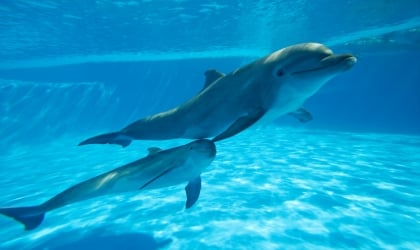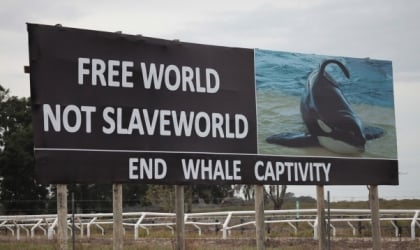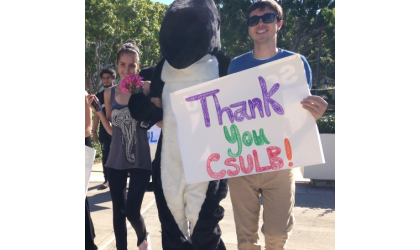Update (March 20, 2023): When Nakai, an orca imprisoned at SeaWorld San Diego, died in a cramped tank last summer, we had major concerns about his long-term well-being. Now, we have the results of his necropsy from the U.S. Department of Agriculture’s records.
Nakai’s body yielded multiple conditions linked to long-term stress, including colonic ulcers and pneumonia. These conditions can result from the intimate relationship among mental stress, the immune system, and physical health. It’s possible that Nakai was chronically stressed and immunosuppressed from languishing at SeaWorld and that these conditions were the result. Pneumonia is a leading cause of death for orcas at SeaWorld.
Nakai likely didn’t feel safe at SeaWorld San Diego. He was gravely injured there, when he lost a giant portion of flesh from his jaw during a fight with other aggressive orcas. In the years since his initial trauma, SeaWorld clearly couldn’t even be trusted to foster a safe environment for the other animals it holds captive. An attack among orcas at the facility was reported by a whistleblower in 2021, and less than a year later—and just one day after Nakai’s death—another attack was caught on camera in 2022. Given the history of orca aggression at SeaWorld, which has resulted in the deaths and injuries of other orcas and humans, other attacks almost certainly weren’t publicly revealed.
It’s generally accepted among veterinarians that dramatic changes in environment, routine, or social dynamics—all tied to the whims of SeaWorld staff—are known stressors for captive orcas and can cause gastrointestinal ulcers and infections such as pneumonia. In their natural habitat, cetaceans have freedom, room to swim, and plenty of stimulation. SeaWorld has always put its profits ahead of its morals by keeping sensitive, deeply emotional cetaceans captive in barren tanks far too small to accommodate their basic needs.
How SeaWorld Can Make Things Right
SeaWorld knows its treatment of cetaceans causes them to suffer mentally and become violent toward their peers and humans, as well as producing chronic stress-induced health problems, yet it still refuses to stop their suffering by releasing them to seaside sanctuaries. In sanctuaries, cetaceans abused by SeaWorld for so many years would finally have the opportunity to swim in the ocean, follow the shifting currents, and dive deep—basic, natural forms of behavior that they can’t engage in inside SeaWorld’s cramped tanks.
If you want to help orcas and other animals trapped at SeaWorld, you can start by never visiting SeaWorld or any other abusement park. Join us in urging SeaWorld to end its use of animals and retire them all to seaside sanctuaries:
Update (August 29, 2022): This morning, PETA fired off a complaint to San Diego County District Attorney Summer Stephan, calling on her to investigate and pursue cruelty-to-animals charges against SeaWorld for the physical and psychological suffering that orcas have no option but to endure in the theme park’s tiny concrete tanks, including injuries inflicted by incompatible animals. This follows recent eyewitness video footage of an attack among orcas at SeaWorld San Diego, which resulted in a serious wound to one orca, believed to be Corky, the longest-held captive orca in the world.
In the letter, PETA explains that attacks of this kind are rare in wild orca populations and that when they do occur, orcas can flee from conflict to avoid injury. SeaWorld’s barren tanks, however, prevent the animals from making that evasive move—and from engaging in natural forms of behavior, including foraging and diving. PETA also contends that SeaWorld knowingly houses incompatible orcas together, putting the animals at risk of severe injury and under constant stress.
“It’s like knowingly housing a violent prisoner in a small cell with a vulnerable prisoner, although in this case, the animals’ only ‘crime’ is to have been born,” says PETA Foundation General Counsel for Animal Law Jared Goodman. “Orcas can swim over 100 miles a day in their ocean homes, but in SeaWorld’s cramped tanks, they can’t escape violent attacks, which adds to their suffering.”

Originally published on August 5, 2022:
Just one day after orca Nakai died at SeaWorld after being held there for 21 years, PETA received eyewitness footage from a visitor at SeaWorld San Diego revealing a violent attack among orcas this morning, resulting in a serious wound to at least one of the animals.
The video seemingly shows the injured orca pushed against a ledge. A child can be heard asking, “how is [the orca] still alive?” In an apparent attempt to escape the other orcas, the injured orca appears to “beach” themselves—which is a highly unnatural behavior.
The eyewitness—who was visiting the park with their children—painted a picture of the literal bloodbath, which left their daughter in tears:
“We all immediately saw blood soaking the water, which triggered my 9-year-old daughter to start crying,” the eyewitness said. “We would see bite marks and fresh wounds all over the side of the whale. Every couple seconds, two [or] more orcas would jump out of the water to [continue] attacking the hurt orca.”
Recently-deceased Nakai was involved in a similar incident when he was kept in a tiny concrete tank with incompatible orcas in 2012 and sustained puncture marks and lost a chunk of his jaw in an attack by two of them.

This Bloodbath is on SeaWorld’s Hands
In the ocean—where orcas live in tight-knit groups and foster deep emotional bonds with one another—aggression between orcas within a family pod is almost nonexistent. So why is it so common at abusement parks like SeaWorld?
Marine parks condemn orcas to miserable conditions—small, barren tanks that don’t allow them to swim at high speeds or dive great depths as they would in their natural habitats—causing them extreme stress and frustration. On top of that, it’s not uncommon for incompatible animals to be housed together in these tiny tanks, where they have nowhere to escape conflicts with other frustrated or aggressive animals.
Join PETA to Help Orcas and Other Animals Trapped at Miserable Marine Parks
PETA called on the U.S. Department of Agriculture (USDA) to investigate SeaWorld San Diego for apparently housing incompatible animals together, which likely led to an orca getting attacked and potentially sustaining serious injuries. Because bullying among orcas can be difficult to resolve once it starts, we also called for the immediate separation of this orca to an adequately sized tank.
If you want to help orcas and other animals trapped at SeaWorld, you can start by never visiting SeaWorld or any other abusement park. Click the button below to urge SeaWorld to end its use of animals and retire them all to seaside sanctuaries:




